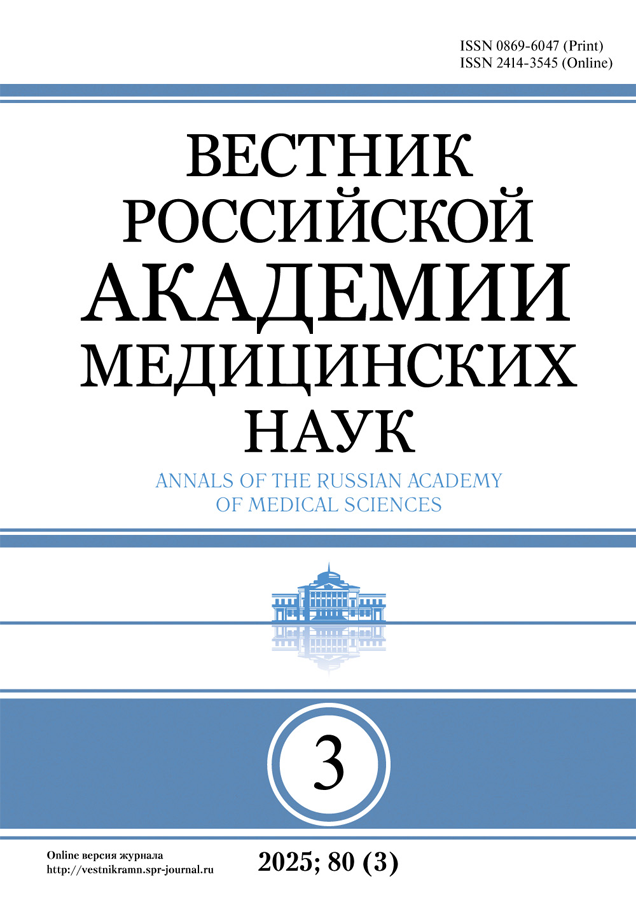ИССЛЕДОВАНИЕ ДИНАМИКИ КЛИНИЧЕСКОГО И МОЛЕКУЛЯРНОГО ФЕНОТИПА ПРИ МИАСТЕНИИ НА ФОНЕ ОПТИМИЗИРОВАННОГО И КОМБИНИРОВАННОГО РЕЖИМА ЛЕЧЕНИЯ
- Авторы: Дрозд О.А.1, Ефремов В.В.1, Романцов М.Г.2, Сарвилина И.В.3
-
Учреждения:
- Ростовский государственный медицинский университет, Российская Федерация
- Северо-Западный медицинский университет им. И.И. Мечникова, Санкт-Петербург, Российская Федерация
- ООО «Медицинский центр «Новомедицина», Ростов-на-Дону, Российская Федерация
- Выпуск: Том 68, № 5 (2013)
- Страницы: 60-64
- Раздел: КРАТКИЕ СООБЩЕНИЯ
- Дата публикации:
- URL: https://vestnikramn.spr-journal.ru/jour/article/view/187
- DOI: https://doi.org/10.15690/vramn.v68i5.664
- ID: 187
Цитировать
Полный текст
Аннотация
Цель работы заключалась в исследовании динамики клинического и молекулярного фенотипа при генерализованной миастении на фоне оптимизированного режима лечения, предполагавшего применение базисной терапии миастении, меглюмина натрия сукцината, а также комбинированного режима лечения, включавшего вышеперечисленные лекарственные препараты и озонотерапию. Достоверное улучшение показателей клинико-неврологического статуса (устранение двигательных расстройств, глазодвигательных нарушений, слабости мимической, дыхательной и жевательной мускулатуры, бульбарного синдрома, двоения в глазах и птоза, глоточных нарушений) наблюдалось у пациентов, получавших комбинированный режим терапии. Выявлено достоверное уменьшение степени выраженности поражения нейромоторного аппарата и декремента амплитуды М-ответа различной степени у пациентов с миастенией при приеме комбинированной терапии по сравнению с приемом базисной и оптимизированной терапии. Впервые исследована динамика интенсивности экспрессии молекул пептидов и белков в сыворотке крови при приеме базисной, оптимизированной и комбинированной терапии, позволившая раскрыть новые механизмы эффективности комбинированной терапии заболевания.
Ключевые слова
Об авторах
О. А. Дрозд
Ростовский государственный медицинский университет, Российская Федерация
Автор, ответственный за переписку.
Email: drozd.oksy@gmail.com
PhD student, Department of Nervous Diseases and Neurosurgery, Rostov State Medical University, Resident, Municipal Budgetary Health-Care Institution City Hospital № 8 in Rostov-on-Don Address: 344029, Rostov-on-Don, Nakhichevan Lane, 29; tel.: (863) 250-41-33 Россия
В. В. Ефремов
Ростовский государственный медицинский университет, Российская Федерация
Email: drozd.oksy@gmail.com
MD, Neurologist, PhD, Associate Professor, Associate Professor, Department of Nervous Diseases and Neurosurgery, Rostov State Medical University. Address: 344029, Rostov-on-Don, Nakhichevan Lane, 29; tel.: (863) 250-41-33 Россия
М. Г. Романцов
Северо-Западный медицинский университет им. И.И. Мечникова, Санкт-Петербург, Российская Федерация
Email: mr@polysan.ru
Doctor of Medical Science, PhD in Pedagogics, Full Member of the Russian Academy of Natural Sciences. Address: 105037, Moscow, PO Box 47 Россия
И. В. Сарвилина
ООО «Медицинский центр «Новомедицина», Ростов-на-Дону, Российская Федерация
Email: isarvilina@mail.ru
PhD, Clinical Pharmacologist, General Director of Ltd. “Medical Center “Novomeditsina” Address: 344002, Rostov-on-Don, Sotsialisticheskaya St., 74 Россия
Список литературы
- Conti-Fine B., Milani M., Kaminski H. Myasthenia gravis: past, present, and future. J. Clin. Invest. 2006; 1, 116 (11): 2843–2854.
- McGrogan A., Sneddon S., de Vries C. The incidence of myasthenia gravis: a systematic literature review. Neuroepidemiology. 2010; 34: 171–183.
- Gekht B.M., Sanadze A.G. Myasthenia gravis: diagnosis and treatment. Nevrologicheskii zhurnal – Journal of neurology. 2003; 8 (Appendix 1): 8–11.
- Romanov T.V. Ways to optimize the diagnostic and therapeutic care to patients with myasthenia gravis (analysis of regional experience myasthenic center). Prakticheskaya meditsina = The practice of medicine. 2012; 2 (57): 153–157.
- Likhachev S.A., Astapenko A.V., Kulikova S.L. Modern approach to the treatment of myasthenia gravis. Neurology and Neurosurgery. Vostochnaya Evropa = Eastern Europe. 2012; 1 (13):.4–11.
- Giraud M., Vandiedonck C., Garchon H. Genetic factors in autoimmune myasthenia gravis. Ann. N.Y. Acad. Sci. 2008; 1132: 180–192.
- Sanadze A.G., Gekht B.M., Sidnev D.V., Khlebnikova N.N., Chugunova N.A., Shcherbakova N.I. Antibodies to acetylcholine receptor in the diagnosis of myasthenia gravis and other forms associated with the pathology of neuromuscular transmission. . Nevrologicheskii zhurnal = Journal of neurology. 2003; 8 (Prilozhenie 1): 19–21.
- van den Broeck J., Vrolix K., Janssen S., Lemmens M., Van Der Esch E., Duimel H., Frederik P., Molenaar P., Martínez-Martínez P., De Baets M., Losen M. Antibody effector mechanisms in myasthenia gravis-pathogenesis at the neuromuscular junction. Autoimmunity. 2010; 43: 353–370.
- Cavalcante P., Barberis M., Cannone M., Baggi F., Antozzi C., Maggi L., Cornelio F., Barbi M., Didò P., Berrih-Aknin S., Mantegazza R., Bernasconi P. Detection of poliovirus-infected macrophages in thymus of patients with myasthenia gravis. Neurology. 2010; 74: 1118–1126.
- Stefansson K., Dieperink M., Richman D., Marton L. Sharing of epitopes by bacteria and the nicotinic acetylcholine receptor: a possible role in the pathogenesis of myasthenia gravis. Ann. N.Y. Acad. Sci. 1987; 505: 451–460.
- Chien P., Yeh J., Chiu H., Hsueh Y. Inhibition of peripheral blood natural killer cell cytotoxicity in patients with myasthenia gravis treated with plasmapheresis. Eur. J. Neurol. 2011; 18: 1350–1357.
- Gideline for the treatment of autoimmune neuromuscular transmission disorders. Eur. J. Neurol. 2006; 13: 691–699.
- Mantegazza R. Bonanno S., Camera G., Antozzi C. Current and emerging therapies for the treatment of myasthenia gravis. Neuropsych. Dis. Treat. 2011; 7: 151–160.
- García-Carrasco M., Escarcega R., Fuentes-Alexandro S., Riebeling C., Cervera R. Therapeutic options in autoimmune myasthenia gravis. Autoimmun. Rev. 2007; 6: 373–378.
- Jordi D. Treatment strategies for myasthenia gravis. Exp. Opin. Pharmacotherap. 2009; 10 (8): 1329–1342.
- Gold R., Hohlfeld R., Klaus V. Toyka progress in the treatment of myasthenia gravis. Ther. Adv. Neurol. Disord. 2008;1 (2): 36–51.
- Huang C., Lin S., Liao P., Young S., Yang C. The immunopharmaceutical effects and mechanisms of herb medicine. Cell Mol. Immunol. 2008; 5: 23–31.
- Myasthenia Gravis: Recommendations of clinical research standards. Neurology. 2000; 55 (1): 16–23.
- Tüzün E., Huda R., Christadoss P. Complement and cytokine based therapeutic strategies in myasthenia gravis. J. Autoimmun. 2011; 37: 136–143.
- Yeh J., Wang S., Chien P., Shih C., Chiu H. Changes in serum cytokine levels during plasmapheresis in patients with myasthenia gravis. Eur. J. Neurol. 2009; 16: 1318–1322.
- Hortin G. The MALDI-TOF mass spectrometric view of the plasma proteome and peptidome. Clin. Chem. 2006; 52: 1223–1237.
Дополнительные файлы








